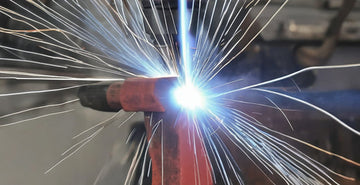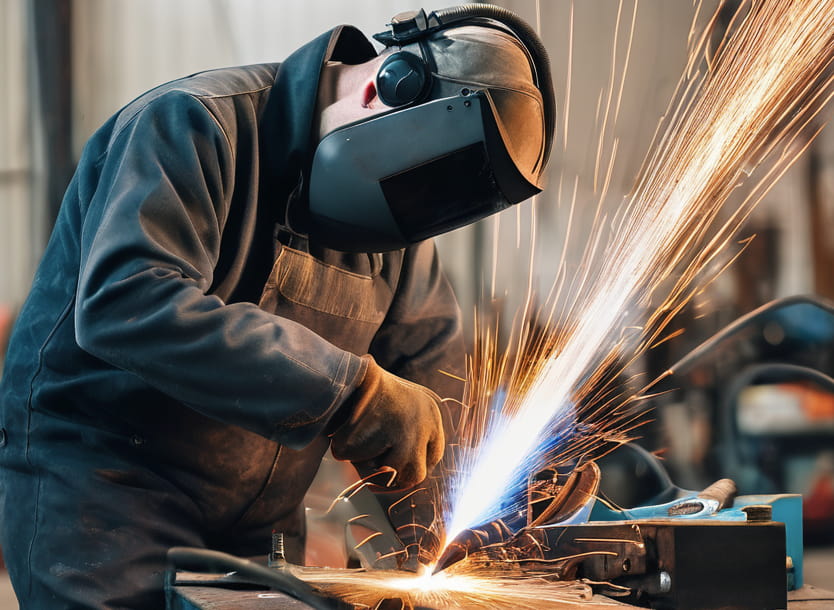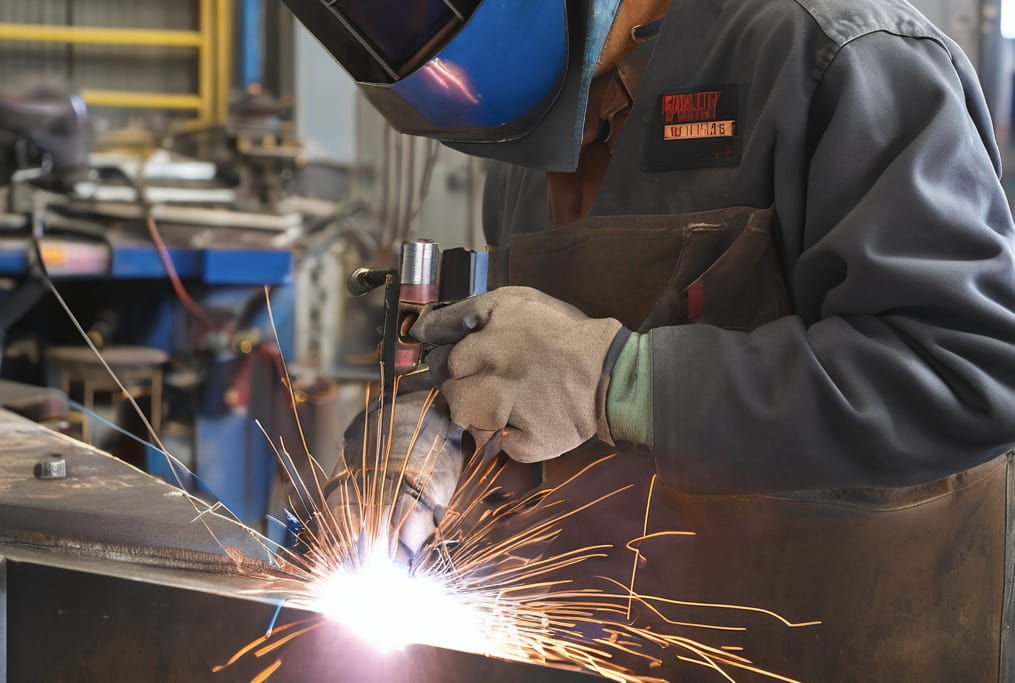
Welding is a crucial process in various industries, from construction to manufacturing. One of the essential aspects of welding is polarity, which plays a significant role in determining the quality and characteristics of the weld, particularly when using a consumable electrode.
In this blog post, we'll dive into the concept of polarity in welding and explain its importance.
What Is Polarity in Welding?
Polarity refers to the direction of current flow in an electric circuit. In welding, polarity determines which part of the welding circuit carries the majority of the current and heat.
The two types of polarity in welding are direct current electrode positive (DCEP), where the majority of the heat is concentrated at the electrode, and direct current electrode negative (DCEN), where the majority of the heat is concentrated at the workpiece.
Direct Current Electrode Positive (DCEP)
In DCEP welding, the electrode is connected to the positive terminal, and the workpiece is connected to the negative terminal of the power source.
The current flows from the electrode tip to the workpiece, causing the electrode to become very hot and possibly resulting in a shorter electrode life. DCEP is often used in shielded metal arc welding (SMAW) and flux cored arc welding (FCAW) because the high heat at the electrode ensures proper melting of the flux and filler metal.
Direct Current Electrode Negative (DCEN)
In DCEN welding, the electrode is connected to the negative terminal, and the workpiece is connected to the positive terminal of the power source. The current flows from the workpiece to the electrode, resulting in most of the heat concentrating at the workpiece. DCEN polarity provides deeper weld penetration and is commonly used in gas tungsten arc welding (GTAW) and submerged arc welding (SAW).
In summary, polarity is a key factor that determines where the majority of heat will be concentrated in the welding circuit. Selecting the proper polarity based on the welding process and desired weld characteristics is crucial for producing high-quality welds.
With an understanding of polarity and how it influences welding, welders and welding instructors can optimize their welding technique and the quality of their welds.
The Importance of Polarity in Welding

Selecting the correct polarity is crucial for achieving the desired weld characteristics and quality. Here are some reasons why polarity matters in welding: it influences arc heat, penetration depth, and the overall quality of the weld.
- Penetration: Polarity affects the depth of penetration. DCEN provides deeper penetration, making it suitable for thicker materials, while DCEP offers shallower penetration, ideal for thin materials.
- Weld Bead Profile: The choice of polarity influences the shape and appearance of the weld bead. DCEP produces a wide, flat bead, while DCEN creates a narrower, more concentrated bead, demonstrating the differences in straight and reverse polarity.
- Arc Stability: This is crucial for maintaining consistent weld quality, particularly when using different types of polarity. Polarity impacts arc stability. DCEP generally produces a more stable arc with less spatter, making it easier to control the welding process.
- Electrode Life: The polarity used affects the life of the welding electrode, and using the wrong polarity can lead to a shorter electrode life. DCEP typically results in longer electrode life compared to DCEN.
When to Use Straight Polarity vs Reverse Polarity
Straight Polarity (DCEN)
Straight polarity, also known as direct current electrode negative (DCEN), is when the negative pole of the welding power supply is connected to the electrode.
The heat is concentrated on the workpiece, allowing for deep penetration. This makes straight polarity ideal for welding thick sections of high-carbon steel, as well as non-ferrous metals like aluminum or magnesium.
Reverse Polarity (DCEP)
With reverse polarity, or direct current electrode positive (DCEP), the positive pole is connected to the electrode. This causes the heat to concentrate on the electrode, resulting in a shallow, wide weld pool.
Reverse polarity minimizes burn-through on thin sheets of metal. It also reduces spatter, making it useful for welding materials that produce heavy spatter, such as stainless steel.
Choosing the Right Polarity

Selecting the appropriate polarity is crucial for achieving the desired weld characteristics and quality, especially when considering direct current straight polarity.
The choice of polarity depends on several factors, including material thickness, desired penetration depth, required weld bead profile, welding position, and electrode type and size, as well as the base plate material. Let's explore these factors in more detail.
Material Thickness
The thickness of the material being welded plays a significant role in determining the right polarity. As a general rule:
- For thin materials (less than 1/8 inch or 3.2 mm), use Direct Current Electrode Positive (DCEP) for shallower penetration and a wider, flatter weld bead.
- For thicker materials (greater than 1/8 inch or 3.2 mm), use Direct Current Electrode Negative (DCEN) for deeper penetration and a narrower, more concentrated weld bead.
Desired Penetration Depth
The desired penetration depth is another critical factor in choosing the correct polarity. If deep penetration is required, such as in the case of welding thick materials or creating strong, load-bearing joints, DCEN is the preferred choice.
On the other hand, if shallow penetration is desired, such as when welding thin materials or creating cosmetic welds, DCEP is the better option.
Required Weld Bead Profile
The desired weld bead profile also influences the choice of polarity, which can be affected by the use of constant polarity. DCEP produces a wide, flat weld bead, which is ideal for creating smooth, even welds with minimal surface irregularities.
This polarity is often used for welding sheet metal or creating decorative welds. In contrast, DCEN produces a narrower, more concentrated weld bead, which is suitable for applications requiring deeper penetration and a more focused heat input.
Welding Position
The welding position can also affect the choice of polarity. In some cases, certain welding positions may be more challenging to execute with a particular polarity.
For example, when welding in the vertical or overhead position, DCEP may be preferred due to its more stable arc and reduced spatter, making it easier to control the weld pool.
Electrode Type and Size
The type and size of the electrode being used can also influence the choice of polarity. Some electrodes are designed to work best with a specific polarity, such as positive polarity or negative polarity.
For instance, certain flux-cored electrodes may require DCEN for optimal performance, while others may work better with DCEP. Always consult the electrode manufacturer's guidelines to determine the recommended polarity for the specific electrode being used.
Additionally, the electrode size can affect the polarity choice. Larger diameter electrodes generally require higher amperage settings, which may necessitate the use of DCEN for better penetration and arc stability.
Manufacturer's Guidelines and Welding Procedures
When in doubt, always refer to the manufacturer's guidelines and welding procedures for the specific materials and electrodes being used. These resources provide valuable information on the recommended polarity, amperage settings, and other crucial parameters to ensure the best welding results.
Welding procedure specifications (WPS) are documents that outline the specific parameters and techniques required to produce a weld that meets the necessary quality standards.
These specifications take into account factors such as material type, thickness, joint design, and welding position, and guide the appropriate polarity, amperage, voltage, and other settings.
How Polarity Affects the Welding Arc and Joint
Polarity refers to the direction of current flow in an electrical circuit, and understanding this is essential for effective dc welding, especially when considering alternating current polarity.
In welding, polarity determines the direction of heat in the arc and affects the properties of the weld, making it essential to avoid wrong polarity.
The two types of polarity used in welding are direct current electrode negative (DCEN), where the electrode is negative; and direct current electrode positive (DCEP), where the electrode is positive.
DCEN (Direct Current Electrode Negative)
With DCEN, the current flows from the electrode to the workpiece. This concentrates heat on the workpiece, causing deeper penetration. DCEN is suitable for welding steel and is often used for thicker sections, where the choice of positive or negative polarity can affect penetration.
The weld has a smooth, shallow reinforcement and minimal spatter, which can be enhanced by using the correct electrode tip and polarity.
DCEP (Direct Current Electrode Positive)
In DCEP, current flows from the workpiece to the electrode. This concentrates heat on the electrode, resulting in a broad, shallow weld with poor penetration. DCEP produces a rounded, convex bead with significant spatter. DCEP is typically used for welding non-ferrous metals such as aluminum alloys that require less penetration.
The polarity used depends on the welding process and the properties required in the weld, including the welding current. For shielded metal arc welding and gas tungsten arc welding of steel, DCEN is commonly used as it provides greater penetration.
DCEP, on the other hand, is used for gas metal arc welding of aluminum alloys where less penetration is required. In some welding processes like flux-cored arc welding, either DCEN or DCEP can be used depending on the welding wire and desired properties.
By controlling the direction of current flow and heat, polarity allows welders to obtain the appropriate amount of penetration and reinforcements required for various welding applications, particularly with direct current reverse polarity.
Proper selection of polarity is crucial to produce high-quality and structurally sound welds. Understanding how polarity affects the welding arc and joint helps welders determine optimal settings for their specific welding tasks.
Polarity Selection Guidelines for Common Welding Processes
Shielded Metal Arc Welding (SMAW)
For shielded metal arc welding (SMAW), also known as stick welding, either direct current electrode positive (DCEP) or direct current electrode negative (DCEN) can be used. DCEP provides deeper penetration and is often used for welding thicker materials.
DCEN provides a smoother arc, higher welding speed, and less spatter, making it suitable for welding thinner materials, particularly when using a dc straight configuration. Alternating current (AC) is not recommended for SMAW due to the uneven heat and arc instability it produces.
Gas Metal Arc Welding (GMAW)
For gas metal arc welding (GMAW), also known as MIG welding, DCEN polarity should be used when welding with solid wire and inert shielding gasses like argon and helium.
The negative polarity provides a stable arc, high welding speeds, and low spatter. DCEP can be used for welding with active gasses like CO2, producing a more penetrating arc heat. AC power is not suitable for GMAW as it does not provide the constant arc voltage necessary for the process, unlike DC straight.
Flux-Cored Arc Welding (FCAW)
For flux-cored arc welding (FCAW), DCEN polarity should be used when welding with gas-shielded flux-cored wires, providing low spatter and shallow penetration.
DCEP polarity can be used for self-shielded flux-cored wires, producing higher penetration. AC power is not recommended for FCAW as the arc is unstable and produces excessive spatter.
Gas Tungsten Arc Welding (GTAW)
For gas tungsten arc welding (GTAW), also known as TIG welding, DCEN polarity is typically used when welding with an inert shielding gas like argon.
The negative polarity concentrates the heat at the workpiece, allowing for precise control of the weld puddle and enhancing the arc heat, which is especially important in dc welding applications.
DCEP can also be used but may lead to tungsten inclusions in the weld. AC power produces an unstable arc and is not suitable for GTAW.
The selection of polarity for a welding process depends on the specific wire, shielding gas, and joint requirements. Following the guidelines helps ensure high-quality, defect-free welds.
Conclusion
Selecting the right polarity is crucial for weld quality and characteristics. Factors like material thickness, desired penetration, bead profile, welding position, and electrode type all play a role in this decision.
Always follow manufacturer guidelines and welding procedures for best results.
Arccaptain offers expertise in choosing the right polarity, including DC straight polarity, for your welding projects. Our experienced team can provide valuable insights to help both beginners and experienced welders achieve optimal outcomes. Visit Arccaptain to support your welding journey with the knowledge you need for success.
FAQs about What is Polarity in Welding
What is polarity in welding, and why is it important?
Explains the basic concept of electrical polarity in welding processes and its significance in achieving optimal welding performance and results.
How does polarity affect the welding process?
Discusses the impact of different polarities (DCEN, DCEP, AC) on weld penetration, bead shape, and spatter generation, and how it influences the choice of electrode and material being welded.
What are the differences between DCEN, DCEP, and AC polarity in welding?
Breaks down the characteristics of Direct Current Electrode Negative (DCEN), Direct Current Electrode Positive (DCEP), and Alternating current (AC) polarity, including their applications and effects on welding.
How do I choose the right polarity for my welding project?
Provides guidelines on selecting the appropriate polarity based on the welding process (e.g., MIG, TIG, Stick), material type, and desired weld characteristics.
Can I switch polarity during a welding project, and if so, how?
Addresses whether it's possible and advisable to change polarity mid-project, including practical steps for safely switching polarity on different types of welding machines.
